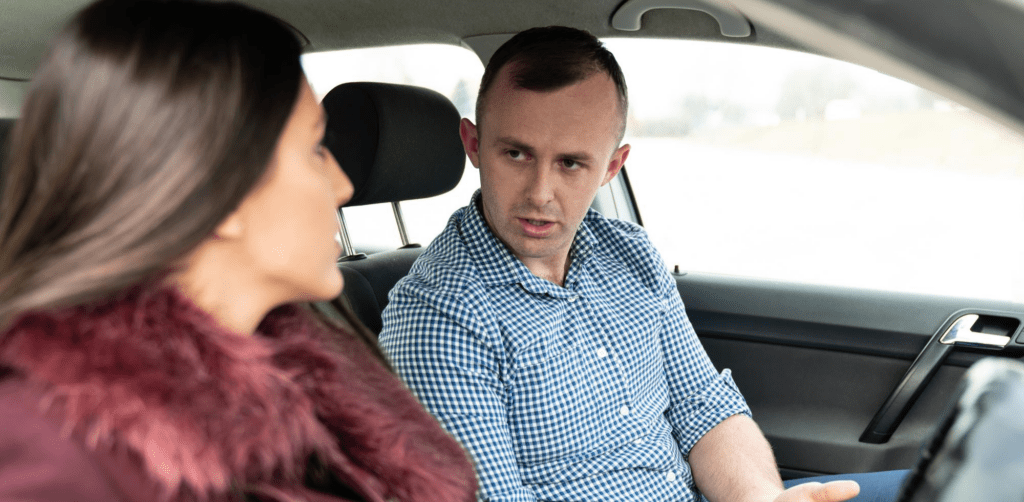
Driving while pregnant can be a challenging experience for learner drivers. The stress of learning to drive is already present, and being pregnant adds another layer of complexity.
Making the decision to learn to drive while pregnant requires careful thought, considering the advantages, disadvantages, regulations, and potential risks involved.
In this comprehensive guide, we will address the safety aspect of driving while pregnant and explore the DVSA’s recommendations for pregnant learners taking the driving test.
- Is it safe to drive while pregnant?
- When should I stop driving?
- Can I take the driving test while pregnant?
- Tips for pregnant learners
- Should I keep learning to drive while pregnant?
- Frequently asked questions
Additionally, we will offer useful tips on how to ensure your safety and comfort throughout the learning process. Our aim is to provide you with the necessary guidance to make an informed decision about whether to proceed with taking the driving test while pregnant. Read on to find all the information you need.
Is it safe to drive while pregnant?
Many pregnant women choose to learn to drive as it offers convenience during pregnancy and can be beneficial when raising a newborn. It’s understandable that finding time to learn after becoming a new mom can be challenging.
However, there are several drawbacks to learning to drive while pregnant. Pregnancy itself is a demanding experience, and adding the stress of driving lessons can be overwhelming. Additionally, there’s the concern of completing the driving course before your due date.

The most crucial consideration for pregnant learners is safety. Driving always carries some level of risk, and these risks become more pronounced during pregnancy.
Thankfully, professional driving instructors (ADIs) are well-acquainted with the challenges faced by learner drivers, including pregnant learners. They are equipped to take control and ensure safety during lessons.
Generally, driving during most of your pregnancy is considered safe. Nevertheless, there are multiple factors you should carefully assess when deciding whether to continue with your driving lessons while pregnant. Safety should always be a top priority in making this decision.
Medical advice
As you advance in your driving lessons, it is crucial to listen to your physician concerning your health. Although most doctors will likely affirm your capability to drive, there might be exceptional situations that could impact your well-being or safety unexpectedly.

Given that every pregnancy varies, it is essential to take all the essential precautions to ensure your safety while driving.
Stage of pregnancy & symptoms
Driving during pregnancy can present several challenges due to fluctuating hormones and significant physical changes. The impact of these symptoms may vary depending on the stage of your pregnancy.
Generally, the first and second trimesters are more manageable for driving, even though discomfort is common. However, as your pregnancy progresses, symptoms like morning sickness, general nausea, swelling, and fatigue can become more pronounced.
These symptoms can occur unexpectedly, making the learning process quite challenging. For instance, nausea may make it difficult to be in an enclosed space, while swelling around the ankles can limit your ability to drive for extended periods.
Additionally, your growing bump may require frequent adjustments to the steering wheel and seating arrangements.
Despite these difficulties, driving during pregnancy is not impossible. There are ways to alleviate the symptoms and make the experience more comfortable. Some pregnant women find relief in peppermint tea to ease nausea and morning sickness, though it may lead to more frequent restroom breaks.
To make driving more bearable, you can request your instructor to open a window for fresh air or take frequent breaks during the lessons.
Remember, every pregnancy is unique, and if you find it challenging to concentrate or manage these symptoms effectively, it might be worth considering postponing your driving lessons until after giving birth. Your health and safety, as well as that of your baby, should always be the top priority.
Your instructor’s advice
When it comes to learning to drive while pregnant, it’s essential to consider not only your doctor’s advice but also your driving instructor’s perspective.
Your instructor’s input is valuable because, depending on your experience level, you may spend a significant amount of time, often up to 50 hours, in a car with them during your lessons.

Throughout this extensive training period, your instructor will have the opportunity to become familiar with your driving style and assess how you handle various situations on the road.
They can gauge whether you are capable of safely completing your lessons and taking your driving test. Their expertise allows them to identify any potential risks or concerns, ensuring your safety and the safety of others on the road.
If, during your lessons, your instructor observes any indications that you might pose a risk to yourself or others due to pregnancy-related discomfort, distractions, or limitations, they may suggest postponing your driving test until a more suitable time.
It’s crucial to heed their advice, as they have your best interests at heart and want to ensure you are prepared and capable of driving safely during this unique phase of your life.
Remember, safety should always be the top priority when learning to drive, especially when pregnant.
Your instructor’s guidance, combined with your doctor’s advice, can help you make informed decisions about the most appropriate timing for your driving test and ensure a smooth and secure learning process.
When should I stop driving?
Deciding when to stop learning to drive during pregnancy involves considering several factors. Some women choose to pause their driving lessons shortly after discovering their pregnancy, while others continue driving and even take their driving test well into the third trimester.
In general, many pregnant learners tend to halt their driving lessons when they reach around 30 weeks, just before entering the third trimester. If your goal is to obtain your driving licence, it is advisable to book your test before reaching the third trimester.

This way, you’ll have a better chance of completing your lessons and taking the test on time. However, if there isn’t sufficient time to do so before the third trimester, you may need to consider taking the test after giving birth.
In some cases, you might find yourself in a situation where you have completed half of your driving lessons but realise that you won’t have enough time to pass the test before the third trimester. In such instances, it may be necessary to postpone the driving test until after you’ve given birth.
Ultimately, the decision to continue or pause driving during pregnancy is entirely up to you and depends on your comfort level. As your pregnancy progresses, you may experience increasing discomfort while driving.
Fatigue and the growth of your baby bump can make it more challenging to handle driving tasks. If you feel uneasy or unsafe, it is essential to listen to your instincts and consider postponing the test date. Your well-being and the safety of yourself and your baby are of paramount importance.
Remember, every pregnancy is different, and there is no one-size-fits-all approach. Take the time to evaluate how you feel while driving and consult with your doctor and driving instructor to make an informed decision.
Your health and comfort should be prioritised, and if needed, you can always reschedule your driving test to a more suitable time.
Can I take the driving test while pregnant?
If you have enough time to complete your driving lessons and take the practical test before reaching an advanced stage in your pregnancy, you might be considering whether it’s safe and feasible to do so.
Let’s explore the rules and challenges associated with taking the driving test during pregnancy, as well as what the DVSA (Driver and Vehicle Standards Agency) has to say about it.
According to the DVSA – ‘You can take a driving test at any stage of your pregnancy. However, you must be able and willing to do an emergency stop.’
The practical driving test includes an emergency stop scenario, and all candidates, regardless of pregnancy, have an equal chance of being asked to perform it. If you are unable to execute the emergency stop during the test, it will result in a failure.
Moreover, passing the driving test requires meeting certain expectations in terms of safe driving skills and confidence. The test evaluates whether you can drive on the roads independently and responsibly. While pregnant, some aspects of the test may pose additional challenges.
For instance, performing manoeuvres such as pulling up on the right, reverse parallel parking or bay parking require thorough all-around observations. As your pregnancy progresses, these observations might become more difficult and uncomfortable to execute.
To gain more insight into your readiness for the driving test, you can ask your instructor to conduct a mock test, if safe to do so. A mock test can help them assess your preparedness and provide you with valuable practice, making you feel more at ease for the actual test.

Ultimately, the decision to take the driving test during pregnancy should prioritise your safety and well-being. If you feel confident and physically able to meet the test requirements, you may proceed with the test.
However, if you have concerns or doubts about your readiness, it’s essential to discuss them with your instructor and healthcare provider. They can offer guidance on the best course of action, ensuring your driving journey is as safe and comfortable as possible.
Tips for pregnant learners
Safety and comfort
Safety and comfort during driving lessons are paramount, especially when you’re pregnant and spending a significant amount of time in your instructor’s car. With around 40 to 50 hours of driving experience typically needed to pass a driving test, it’s crucial to take necessary precautions to ensure a positive learning experience.
First and foremost, prioritise your well-being by being attentive to your body’s signals. If you ever feel fatigued or nauseous during a lesson, don’t hesitate to inform your instructor. They will promptly find a safe location to pull over and arrange for a comfortable return home.

As your pregnancy progresses, it’s essential to make adjustments to your driving position for both safety and comfort. Sit slightly farther back from the steering wheel while ensuring you can still reach the pedals comfortably.
The seat position should also allow for a gap between your bump and the steering wheel. Properly position the seatbelt, ensuring the lap belt rests low on your thighs and the diagonal belt rests between your breasts.
This way, you can minimise any discomfort and ensure the seatbelt is optimally securing you and your baby.
Additionally, choose comfortable clothing for your driving lessons. Opt for light tops to stay cool and consider wearing elasticated waistbands that accommodate your changing body shape without restricting movement.
Beyond physical comfort, remember that frequent breaks and proper hydration are crucial during driving lessons. Pregnancy can make you more susceptible to dehydration, so it’s essential to drink plenty of water before and during your lessons.
It’s essential to communicate openly with your instructor about any concerns or discomfort you experience during your lessons. They can provide additional advice and support to make your driving experience as safe and comfortable as possible.
Prioritising your safety and well-being during this time will contribute to a positive learning journey and help you gain the necessary skills and confidence to become a capable and responsible driver.
Eat before you start your lessons
Staying nourished and hydrated is essential during pregnancy, and that includes when you’re on driving lessons. As the saying goes, you’re eating for two, and your body needs sufficient fuel to keep you going.
Before heading out for your driving lesson, be sure to eat a balanced meal to provide the energy you’ll need. If you have a longer lesson ahead, consider bringing along a nutritious snack to keep you energised during the drive.

If you’re concerned about food breaks impacting your lesson, have an open conversation with your instructor about it. A supportive instructor should understand your situation and be accommodating.
Apart from food, staying hydrated is crucial. Drinking plenty of water throughout the day will help you stay alert and prevent fatigue during your lessons.
However, do keep in mind that increased water intake may lead to more frequent toilet breaks. Plan for this and communicate with your instructor to find appropriate breaks during your lessons.
Remember, taking care of your physical well-being while driving during pregnancy is essential for your safety and that of your baby. Don’t hesitate to prioritise your needs and communicate any concerns or requirements with your instructor.
By ensuring you’re well-fed, hydrated, and comfortable during your driving lessons, you’ll be better equipped to focus on learning and gaining the necessary skills to become a confident and capable driver.
Don’t push yourself
Avoid pushing yourself too hard during your driving lessons, especially when you’re pregnant. Although the temptation to go for longer, intensive lessons might be there, it’s essential to be mindful of your well-being and any discomforting symptoms you may experience.
Opting for shorter lessons or longer ones with frequent breaks can be more beneficial during pregnancy. These breaks allow you to monitor your circulation, stretch your legs, and ensure you’re comfortable throughout the learning process.

Remember, rushing to complete your lessons and pass the test quickly can potentially worsen your symptoms or put you at risk. Your safety should always be the priority, both for yourself and others on the road. If your driving instructor believes that you’re not ready or that proceeding with the test might be unsafe, they will likely recommend postponing the test.
Listen to your body and communicate openly with your instructor about any concerns or limitations you experience during your lessons. They can tailor the lessons to your needs and ensure a more comfortable and safer learning environment.
By taking the time you need and not overexerting yourself, you’ll be better equipped to focus on learning, build your driving skills confidently, and prepare for the driving test when you’re truly ready.
Should I keep learning to drive while pregnant?
We understand it’s a decision that requires careful consideration. To help you weigh your options, let’s take a look at the key pros and cons:
Pros:
- Get it done before birth: Completing your driving lessons and passing the test before giving birth can be advantageous. Afterward, you might find it challenging to make time for driving lessons, and additional lessons later on could cost more.
- Great conversation starter: Pregnancy can be an excellent conversation topic during your driving test, providing a distraction from any test anxiety. It may help you feel more at ease and build rapport with the examiner.
- Motivation factor: Learning to drive while pregnant can serve as a personal deadline and motivator. The impending arrival of your baby can push you to focus and work harder to get your driving license before the due date.
Cons:
- Emergency stop challenge: One in three drivers is asked to perform an emergency stop during the driving test, and pregnant learners are not exempt from this requirement. If you are unable to execute the emergency stop, it could lead to test failure.
- Pregnancy symptoms: Coping with pregnancy symptoms like morning sickness, fatigue, and navigating around your growing baby bump can make the journey toward passing your driving test more difficult and uncomfortable.
- Rushing may lead to failure: If you rush your lessons and test preparation, you risk failing the driving test. Picking a test date that is too soon might not give you enough time to become a confident and capable driver.
Consider your personal circumstances, health, and comfort level when making the decision. Consult with your driving instructor and healthcare provider to assess your readiness for driving lessons and the driving test.
Taking a measured and well-paced approach will increase your chances of success and ensure your safety during this significant life event.
Frequently asked questions
Many pregnant learners express concern about wearing a seat-belt, fearing that it might exert too much pressure on the stomach and pose risks to the baby.
However, research and experts agree that wearing a seat-belt is safer for pregnant drivers than not wearing one at all. It is crucial to follow the recommended method for setting up the seat-belt correctly to ensure maximum safety.
By positioning the lap belt low on the thighs and the diagonal belt between the breasts, the seat-belt distributes the impact forces away from the abdomen, thus reducing the risk of harm to the baby in the event of a collision.
Wearing a seat-belt is a critical safety measure for all drivers, and pregnant women are no exception. It is essential to prioritize the safety of both the mother and the unborn child while driving.
Adhering to the proper seat-belt guidelines ensures that you can protect yourself and your baby on the road and can confidently focus on your driving lessons and preparation for the driving test.
Driving in a car with airbags is generally safe for pregnant learners. Airbags are designed to enhance safety and can provide additional protection for both the driver and the passenger, including pregnant women.
In the event of an accident, airbags can help reduce the risk of severe injuries.
However, as your pregnancy progresses, it is advisable to adjust your seating position in relation to the airbags. As your bump grows, move your seat slightly further back from the steering wheel to ensure there is enough space between you and the airbag.
This adjustment can help mitigate any potential impact on your abdomen from the airbag during deployment.
It’s essential to strike a balance between ensuring your comfort and maintaining proper safety measures. Regularly adjust your seat and seatbelt position to accommodate your changing body shape and to optimize both your safety and that of your baby.
By taking these precautions and adhering to recommended safety guidelines, you can confidently continue your driving lessons and focus on developing the necessary skills to become a responsible and safe driver.
If you find yourself involved in a car accident, it is crucial to prioritise your health and safety. Regardless of how minor you may perceive the accident to be, it is essential to seek medical attention promptly. Even if you feel fine immediately after the accident, some injuries might not manifest symptoms right away.
Visiting your doctor for a thorough check-up is a prudent step to take after an accident. The doctor can assess your condition and look for any potential injuries, even those that might not be apparent at first. Early detection and treatment of injuries can prevent complications and ensure your well-being.
Remember, adrenaline and shock can mask pain or discomfort initially, and injuries may surface later on. So, it’s essential not to dismiss any potential risks and to prioritize your health above all else.
By seeking medical attention after an accident, you can address any issues proactively and take the necessary steps for recovery. Your safety and well-being are of utmost importance, and taking this precautionary measure can provide peace of mind during a potentially stressful situation.
To ensure comfort during your driving lessons, it’s important to pay attention to several key factors.
- Firstly, maintain a proper seating position with your back straight, and ensure the steering wheel is at an appropriate distance from you.
- Your feet should comfortably reach the pedals. Adjusting the seat and steering wheel accordingly can help prevent discomfort during long lessons.
- Wear comfortable and loose-fitting clothing that allows for ease of movement. Supportive shoes are also essential for maintaining proper control over the pedals and ensuring comfort throughout the lesson.
- Staying hydrated and nourished is vital for overall well-being during driving lessons. Bring a bottle of water and some snacks with you to stay energized and focused. If necessary, take breaks during longer lessons to stretch your legs and refresh yourself.
By taking these measures, you can create a more comfortable learning environment and concentrate on building your driving skills with ease.
Comfort during lessons will contribute to a positive experience, making it more enjoyable and effective as you work towards becoming a confident and safe driver.
If you don’t pass your driving test, don’t be disheartened; it’s a common experience for many learners. The good news is that you can usually book another test, depending on your current stage of pregnancy and other circumstances. Failing a driving test doesn’t mean the end of your journey towards obtaining a driver’s license.
Take the opportunity to review the areas where you may need improvement and work on honing your skills. Additional practice and guidance from your instructor can help you become more confident and better prepared for the next attempt.
Remember that each driving test is a learning experience, and with determination and perseverance, you can increase your chances of success in subsequent attempts.
The important thing is not to give up and to keep striving for your goal. Many learners need more than one attempt to pass their test, and that’s completely normal.
Stay positive, learn from the feedback given by your instructor and the examiner, and use it as a stepping stone to improve your driving abilities. With continued effort and dedication, you’ll increase your chances of passing the test and becoming a safe and capable driver.
The timeline for resuming driving after giving birth varies for each individual. Generally, it’s advisable for new mothers to prioritise rest and recovery during the initial days following childbirth. When it comes to driving, it’s best to wait a few weeks until you feel physically and mentally ready to return to the road.
Taking into consideration your unique postpartum recovery and any potential medical considerations, it’s essential to consult with your doctor before making a decision. They can assess your overall health and provide personalised advice on when it is safe for you to resume driving.
New mothers should not rush into driving immediately after giving birth, as the body undergoes significant changes during pregnancy and delivery. It’s crucial to give yourself sufficient time to heal and regain strength before taking on the responsibilities of driving.
Ultimately, your well-being and safety, as well as that of your baby, should be the top priority. Listen to your body, seek medical guidance, and make an informed decision about when to resume driving based on your individual circumstances.
With the right care and consideration, you’ll be better prepared to handle the demands of driving and ensure a smooth transition back to regular activities after childbirth.


